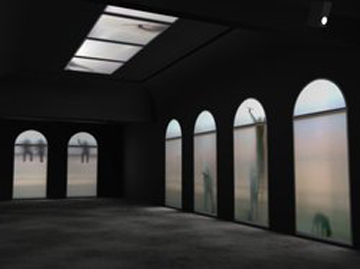
Krzysztof Wodiczko, "Goście / Guests," 2008-2009, video projection, project visualization. Photos courtesy of the Artist and Zachęta National Gallery of Art.
Entitled Goście / Guests, Krzysztof Wodiczko’s exhibition greets visitors to the Venice Biennale’s Polish Pavilion with the words of political theorist Hannah Arendt: “Refugees driven from country to country represent the avant-garde of their people.” Obviously, Arendt is not referring to “avant-garde” in the artspeak sense that you and I may be accustomed to. Rather, she suggests that the state of displacement is one that will be experienced by entire populations, rather than small persecuted groups. The proclamation comes from Arendt’s 1943 article, “We Refugees,” which calls for a resistance to assimilation and predicts the gradual dissolving of European borders and segregated nation-states. In the context of the Biennale, whose very structure upholds the model of the nation-state, the invocation of Arendt is bold, if not contentious.
Stepping inside of the Polish Pavilion, we can see Arendt’s views embodied, as the solid stone building is suddenly rendered porous and thin by Wodiczko’s trompe l’oeil installation. Projections create the illusion of frosted glass floor-to-ceiling windows on every wall. At first, it seems that you can observe goings-on outside the pavilion through these translucent windows. Within each arched “pane” you can see silhouettes of bodies engaged in various activities—speaking on cell phones, vacuuming, resting on suitcases. Voices, which reveal casual conversations that are all related to issues of immigration (i.e. unemployment, legalization documents, etc.), stir your analytical mind and the sensory illusion dissolves—but not completely. Your mind remains unsettled by mirage of surrounding humans.
While it would be easy to say that the characters in these tableaus—clearly immigrants—are guests, your own status as such is also underscored. As the viewer, you are most likely a guest of Venice, and certainly a guest of this space. In Wodiczo’s Art:21 segment, he describes engaging with memorials as “a vehicle through which the past and the future converge.” Though the Polish Pavilion at the Venice Biennale functions much differently than a memorial, I believe that in quoting Hannah Arendt, Wodiczko ties the perpetual flux of today’s “stateless” immigrants to the mass displacement of Jews and other Europeans in WWII, and ultimately implicates the viewer in this ongoing lineage.